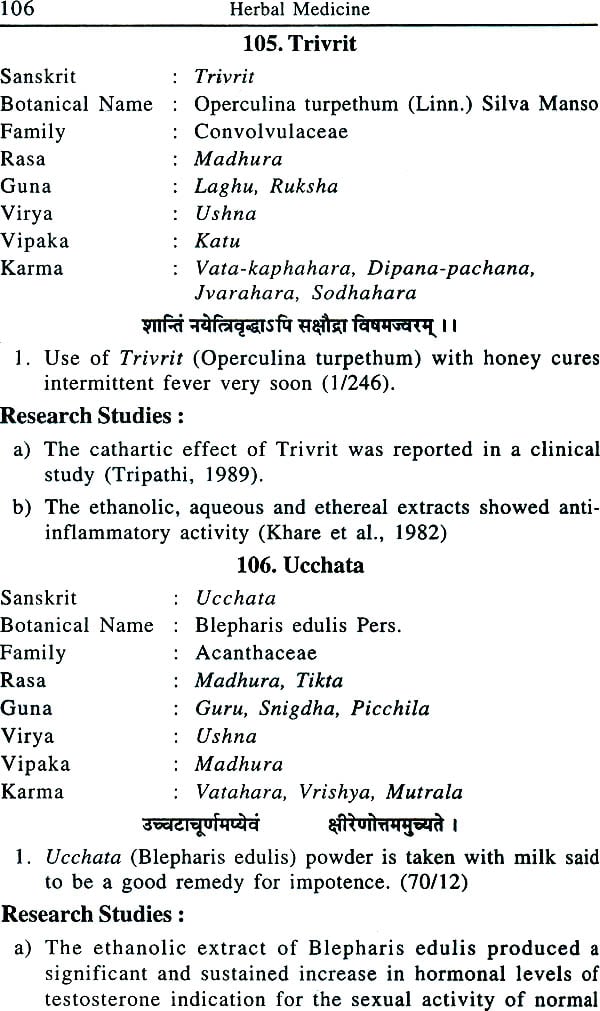
Herbal Medicine (Based on Vrindamadhava)
Book Specification
| Item Code: | NAK096 |
| Author: | Dr. K.J. Lavanya Lakshmi |
| Publisher: | Chaukhambha Orientalia |
| Language: | English |
| Edition: | 2014 |
| ISBN: | 9788176373265 |
| Pages: | 204 (137 Color Illustrations) |
| Cover: | Hardcover |
| Other Details | 9.0 inch x 6.0 inch |
| Weight | 380 gm |
Book Description
India has a glorious tradition of health care system based on plants, which dates back to Vedic era. The Charaka Samhita and the Sushruta are the main treatises of Ayurveda. Over the following centuries, Ayurvedic practitioners developed a number of medicinal preparations and surgical procedures for the treatment of various ailments. Up to 80% of people in India use either Ayurveda or other traditional medicines. Around 1000 B.C, the knowledge of Ayurveda was comprehensively documented in various Samhitas viz. Agnivesa Samhita, Bhela Samhita, Kashyapa Samhita viz. Agnivesa Sushruta Samhita etc. As these treatises were voluminous and are not tangible to the mediocre students of Ayurveda, which lead to compilation of short and snappy works like Ashtanga Sangraha by Vagbhata and the similar method was adopted by the later authors.
During medieval period scholars like Madhavakara, Vrinda-madhava, Tisatacharya, Chakrapanidatta, Vangasena, Sodhala, Sarangadhara and Bhavamishra etc. have compiled the relevant matter essential and suitable to their contemporary periods. Some of the new treatment modalities and new drugs which were introduced into the clinical practice have been incorporated into the medieval Ayurvedic works. In this process they made inclusion of new knowledge in the form of therapeutic procedures and various formulations which are very much beneficial to the mankind in the field of Medicine. They designed safe and effective formulations in simplified and systematic manner. Vrinda (during 9th century A.D) has mentioned that the treatise Siddhayoga was composed by himself after going through many a number of earlier treatises, which was considered as the first published treatise on treatment of diseases and it is popularly known as Vrindamadhava. Some diseases have been taken up by Vrinda which do not appear in Madhavanidana such as Vardhma (Inguinal hernia or lymphadenitis –ch.40) and 'Snayuka' (Dracontiasis or Guinea worm disease-ch.55). Different kinds of therapies required in the management of specific diseases were included as a part of treatment.
Materia medica of Ayurveda includes drugs of Plant origin, Animal Origin and Metals and Minerals. Medicinal plants have traditionally occupied an important position in the socio-cultural, spiritual and medicinal arena of the country. The global plunge areas for drugs from medicinal plants include disease conditions, whose incidence is increasing and where the modern drugs are available with lesser safety profiles. The demand of plant based therapeutics is increasing due to the rising recognition, that they are natural products, being no side – effects, easily available at affordable prices and sometime the only source of health care available to the poor.
Medieval works on Ayurvedic therapeutics have given more emphasis for documentation of single and simple herbal recipes in the place of poly herbal formulation of Ayurvedic classics. Vrinda has carried out his research on single as well as simple herbal formulations and recorded his findings in the book entitled Vrindamadhava or Siddhayoga. Details about Vrinda are unknown except that he might have lived in eastern Bengal, i.e. the country now called Bangladesh. Nischalakara mentioned that Vrindra belongs to Varendra, a region referred to in Siddhayoga. The Siddhayoga is a work on therapeutics in 3,728 verses with some prose expressions, arranged in 82 chapters.
Single drug recipes like Parpataka (Jwara), Jiraka with guda (Vishamahwara), Dhattura (Yuka), Amalaki (Shoola),Pushkaramoola (Hridroga), Varuna (Ashmari), Bilwapatra (Shotha) Vriddhadaru (Sleepad), Bakuci (Kustha), Chakramarda (Dadru), Nirgundi (Snayuka), Asvagandha (Yoniroga), Ashoka (Pradara), Asthisamharaka, Laksha (Bhagna) and parasikayavani (krimi) were included by Vrinda which were copied down by late authors as it is.
| 1 | Introduction | 1 |
| 2 | Historical perspective | 6 |
| 3 | Disease profile | 10 |
| 4 | Single Drug Recipes | 18 |
| 5 | Simple and Compound formulations | 118 |
| 6 | Annexure | |
| List of herbs Identified in Single and Simple recipes | 150 | |
| Flora of Vrindamadhava | 156 | |
| Synonym of the Herbs | 170 | |
| Groups of Herbs | 177 | |
| Colour Atlas or Herbs | 181 |






